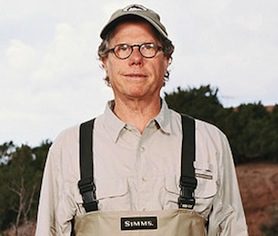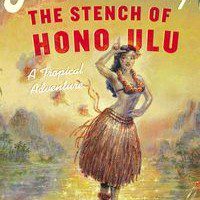If you know Jack Handey from the “Deep Thoughts” he wrote for Saturday Night Live, you probably think of him as a comedy writer. But as Kathleen Rooney recently explained in the New York Times Magazine, Handey is in fact a groundbreaking contemporary poet. Rooney claims that Handey’s “Deep Thoughts” were, poetically at least, ahead of their time. Their “conversationality, concise humor, ludicrous situations, and faux-sincere profundity,” she argues, “presaged rhetorical turns that now appear often in contemporary poetry.”
All this time, right under our noses, Jack Handey has been breaking down the conventions of poetry, destroying old forms to make them new again without us even noticing.
The question raised by Handey’s debut novel, The Stench of Honolulu, therefore, is not what happens in it, what it’s about, or whether it succeeds. No, the question is whether it does for the novel what “Deep Thoughts” did for poetry. Is The Stench of Honolulu, as some have claimed, a bare-bones frame built to prop up 200 pages of hilarious one-liners? Or has Jack Handey invented something wholly new out of the dying husk of yet another literary form?
To answer these questions, I compared The Stench of Honolulu with Aspects of the Novel, E. M. Forster’s classic critical examination of the form. I wanted to know: Is Handey operating within the confines if his chosen genre, or wildly outside of them? It turns out that The Stench of Honolulu breaks almost every rule of novel writing. And it doesn’t just break them, it lays waste to them. Jack Handey is a one-man literary-theory wrecking machine.
Take, for example, the simple question of whether The Stench of Honolulu tells a story. A “story,” Forster explains, is simply a narrative in which one thing happens after another. In The Stench of Honolulu, the narrator and his friend Don go to Honolulu, sail up the mighty Paloonga River in search of the mysterious Golden Monkey, escape the clutches of the evil philanthropist Doctor Ponzari, and duel over the affections of Leilani, a stock native Hawaiian character. All of these things happen one after another, just as Forster prescribed. So The Stench of Honolulu definitely tells a story.
But Forster also insisted (he was English) that a narrative express “the life in time and the life by values.” Of these two, “the allegiance to time is imperative,” Forster wrote. “In a novel,” he said, “there is always a clock.” Is there a clock on the story in The Stench of Honolulu? Not at all. Handey’s characters could go on forever, sailing the mighty Paloonga, abandoning and re-encountering Doctor Ponzari, wooing Leilani and searching for the Golden Monkey until the end of time, and it wouldn’t make any difference to anyone. Handey has daringly, perhaps even audaciously, broken the most basic principle of novel writing — he has failed to tell a story. He has written the very thing Forster cautioned against: A narrative without consequence.

Forster also said that a novel’s story should have a plot, a relationship between cause and effect that generates a mystery the reader must employ her intelligence to solve. Here, again, Handey writes in near-total disregard of novelistic tradition. The turns in his story are more like riggings that Handey constructs to set up the next round of brilliant zingers. Each time the story turned, I didn’t think “Aha, I see now the inevitable course and mystery of human affairs.” I thought, “Hooray, more jokes!”
Finally, Forster wrote that a novel should express a character’s inner life. This is the novel’s gift. No other art form invites us to experience the mystery of what it would be like to inhabit the imagination of another person. But Handey’s narrator doesn’t have an inner life. Consider this early interior monologue, which spans a break between chapters, in which our narrator searches for the perfect nickname for himself during his flight to Hawaii.
The great thing about sitting next to a stranger on an airplane is you can ask him all sorts of questions. “What’s a good nickname for me?” I asked, explaining I had narrowed it down to “Biff,” “Wrong Way,” and “Studs.” He didn’t seem to have a preference. As I sat there slurping on my straw, trying to decide, I said, “Wait a minute! What about ‘Slurps’?” He looked like he was in pain. I don’t blame him — it was a tough one. I went over it in my mind, out loud. I decided I liked “Slurps” better than “Biff” or “Studs,” but not better than “Wrong Way.” Then it hit me: how about “Wrong Way Slurps”!
I turned to the stranger, and that was when I got an idea for an even better nickname: “The Sleep Pretender.”
Honolulu
By the time we started to land, I had changed my nickname back to “Wrong Way Slurps.” It just hits the ear better.
Jack Handey’s narrator is so devoid of an interior life that if spending time inside his head weren’t so hilarious, it would be terrifying.
And so we can see that The Stench of Honolulu violates every rule of novel writing. And yet it isn’t all that bad. In fact, it’s pretty amusing. It definitely kept me entertained for the two hours or so it took me to finish it. Which means Handey has indeed done it again. He has waded into a genre that might seem unsuited to him, broken all the rules, and emerged with a radical reinvention of the form that, all things considered, isn’t half bad.
How did he do it?
First, he kept his novel short. The Stench of Honolulu may be just over 200 pages, but those pages are small (The Stench of Honolulu is roughly the dimensions of a Hardy Boys adventure book), and the type on them is really big. When the book came in the mail, I thought for a moment I had accidentally ordered the large print version. Most of the chapters are three pages long. Some are only two. It’s hard to get tired of a book of hilarious one-liners when that book is so short.
Second, The Stench of Honolulu is really, really funny. It is utterly silly, completely ridiculous, and hilarious. Handey’s jokes are so inventive, and so consistently excellent, you still can’t see them coming, even after almost 200 pages.
True, some readers will tire of a novel composed entirely of set-ups and top-shelf one-liners, even if they are strung together into a wacky, absurdist narrative. But more adventurous readers, along with those with more time on their hands, will, I think, press on, knowing they are reading not just the work of a comic genius, but the work of a budding literary genius as well.




